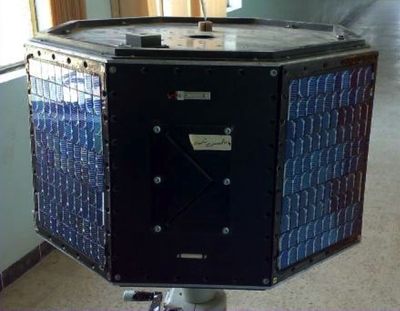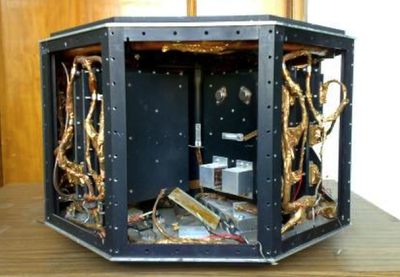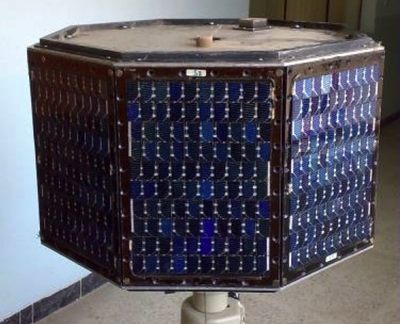Iraqi bird: Beyond Saddam’s space programby Dwayne A. Day
|
| The research center’s plan was to launch one of the satellites aboard an Ariane 4 rocket, and the spacecraft designers used an Ariane 44L vehicle as their baseline. |
The details of the Iraqi satellite effort are contained in a presentation made by one of the former scientists involved in the program at a recent small satellite conference. According to Sarmad D.S. Dawood of the Space Applications Center of the Space Technology Directorate within Iraq’s Ministry of Science & Technology in Baghdad, from 1988 until 1990 Iraq’s Scientific Research Council established a research center to develop space technology. The research center started the Al-Ta’ir project, which means “The Bird” in Arabic (although the name, which is also applied to a star in the constellation Aquila, also apparently translates as “flying eagle”). Al-Ta’ir was a small experimental satellite for conducting communications and ranging experiments. It would have operated in the VHF and UHF amateur frequency ranges.
Dawood stated that the research center built two identical flight ready satellites. Surprisingly, the satellites still exist and are in storage at the Ministry of Science & Technology in Baghdad. The project also included a tracking, control, and communications station.
 A photo of the Al-Ta’ir satellite built by Iraqi scientists and engineers between 1988 and 1990. (credit: Sarmad D.S. Dawood) |
The research center’s plan was to launch one of the satellites aboard an Ariane 4 rocket, and the spacecraft designers used an Ariane 44L vehicle as their baseline. Their plan was to launch the satellite into an orbit of 350–400 kilometers, presumably as a secondary payload. One aspect of this plan that remains confusing is that the Ariane 4 only flew to polar low Earth orbit or to geostationary transfer orbit. Presumably the Iraqi engineers would have preferred a low inclination low Earth orbit to maximize the time the satellite flew over their country, but the Ariane 4 never demonstrated this capability.
The satellite was an octagon with a height of 47 centimeters, a diameter of 74 centimeters, and a mass of 75 kilograms. It looks somewhat like a 1970s-era disco-themed coffee table. The interior of the satellite was divided into four bays for holding electronic boxes and withstanding the shock and vibration of launch. The satellite was solar powered, with seven solar panels and backup batteries.
The satellite subsystems included an onboard data handling system, a radio frequency communication system composed of VHF and UHF amateur band units that communicated voice and telemetry and telecommand data, and an attitude control system. Thermal control was passive, using light and dark paint.
The satellite was spin-stabilized. Attitude control would have been accomplished with a technique first developed by the United States military in the early 1960s consisting of two coils mounted on the top and bottom sides of the spacecraft. These coils would interact with the Earth’s magnetic field, keeping the satellite properly oriented.
According to Dawood, the program came to a halt as Iraq’s deteriorating relationship with the western world prevented the country from obtaining access to the Ariane 4. What remains unclear is if the Al-Ta’ir satellite was also intended for launch aboard Iraq’s indigenous satellite launching vehicle, the Al Abid. On December 5, 1989, Iraq launched a 25-meter long rocket from a launch pad 230 kilometers southwest of Baghdad. This was a test of the first stage of the Al Abid and the second and third stages were only mockups.
The United Nations Monitoring, Verification and Inspection Commission, known as UNMOVIC, obtained a number of Iraqi documents in 1995 providing information on Iraqi missile and rocket programs. According to UNMOVIC, Iraq began development of the Al Abid in 1988. The Commission stated that this was a result of Iraq’s failure to gain a cooperative agreement with another country. It seems likely that after being rebuffed by the French government or Arianespace over the use of the Ariane 4, Iraq began development of its own rocket. Al Abid reportedly had several names, including Comet and Al-Ta’ir—either the rocket and satellite programs shared the same name, or UNMOVIC confused the two.
 A photo of the interior of the Al-Ta’ir satellite built by Iraqi scientists and engineers between 1988 and 1990. (credit: Sarmad D.S. Dawood) |
Iraq’s Space Research Corporation initially began studying development of a launch vehicle capable of placing a payload of 100–300 kilograms into an orbit of 200–500 kilometers, although UNMOVIC reported that the planned initial payload was only 50 kilograms. Iraqi engineers chose to develop a clustered rocket design. The third stage diameter was 1.25 meters, more than sufficient to carry the 0.74-meter diameter Al-Ta’ir satellite.
| Since Hussein’s overthrow and the formation of a new Iraqi government, the engineers who worked on Al-Ta’ir have been training new staff about modern satellite technology. |
After the December 1989 test Iraqi engineers decided to test the Al Abid’s second and third stages separately and planned further tests for the fall of 1990. However, Iraq’s invasion of Kuwait in August 1990 and the subsequent military response led by the United States halted all further efforts. According to Dawood, from 1991 to 2003, Iraq continued designing subsystems for more advanced satellite missions such as remote sensing spacecraft. The country’s engineers conducted simulation and modeling of subsystems, including digital imaging cameras. That work halted after the 2003 American invasion of Iraq.
Since Hussein’s overthrow and the formation of a new Iraqi government, the engineers who worked on Al-Ta’ir have been training new staff about modern satellite technology. They are looking into new concepts such as cubesats, and considering international collaboration. Perhaps in the next few years Iraq will be able to build its first satellite and launch it aboard a foreign rocket, achieving a goal first established over two decades ago.
Note: a portion of the UNMOVIC report on the Al Abid satellite launcher can be downloaded here.
Acknowledgements: the author wishes to thank Paolo Ulivi and Jonathan McDowell for their assistance.
